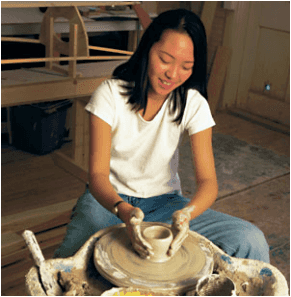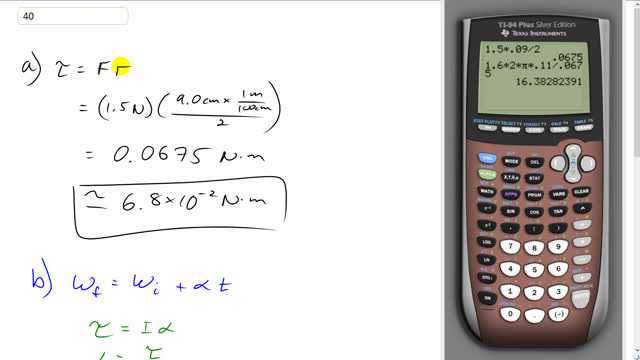
A potter is shaping a bowl on a potter’s wheel rotating at constant angular velocity of 1.6 rev/s (Fig. 8–48). The friction force between her hands and the clay is 1.5 N total.
- How large is her torque on the wheel, if the diameter of the bowl is 9.0 cm?
- How long would it take for the potter’s wheel to stop if the only torque acting on it is due to the potter’s hands? The moment of inertia of the wheel and the bowl is .


In order to watch this solution you need to have a subscription.
This is Giancoli Answers with Mr. Dychko. The force that the potter applies on the bowl is gonna be at a right angle to the line connecting the point of application of the force to the axis of rotation in the center of the bowl so in other words, the force is tangental. So that means we don't have to concern ourselves with angles and we just find the torque by going the force times the distance to the center of the bowl. So the radius of the bowl is the diameter converted into meters divided by 2 So you have 1.5 newtons times 9 centimeters times 1 meter for every 100 centimeters divided by 2 and that's about 6.8 times 10 to the minus 2 newton meters. And to find the time it takes for this bowl to come to a stop, we know that the final angular velocity equals initial angular velocity plus angular acceleration times time and we can figure out the angular acceleration knowing torque and moment of inertia because the net torque equals moment of inertia times angular acceleration and then divide both sides by I and switch the sides around and you get α equals τ divided by I. And so plugging back into here or rearranging this, we have that the final angular velocity is zero because the potter's wheel comes to a stop and so that means we can subtract ω i from both sides and then divide both sides by α and you get the time is negative initial angular velocity divided by angular acceleration. And so when dividing by this, we can instead multiply by its reciprocal and so that's where this comes from— I guess I usually put substitution's in red so let's do that. So instead of dividing by τ over I, I'm going multiply by I over τ and then rewriting it next to it like that and we plug in some numbers. And we have 1.6 revolutions per second is the initial angular velocity— the potter's wheel— and be careful with your units here because typically we are given 'rpm' but in this case, it's rps—revolutions per second— and you have to multiply by 2π radians for every revolution to get it in radians per second and then times by 0.11 kilogram meter squared and divided by this torque that we figured out in part (a). I put a negative sign in front of this torque because its direction must be opposite to the direction of the initial angular velocity and we just wrote that in as a positive number. There's a negative sign here but that's from our algebra part of the formula but the value for the initial angular velocity itself is positive and we know that the torque is opposing it so we'll give it the opposite sign which is negative and we end up with 16 seconds for the amount of time for the potter's wheel to stop.